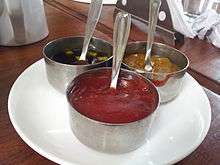Salsa golf
Salsa golf (Spanish for "golf sauce") is a cold sauce of somewhat thick consistency, common in Argentina. According to legend, it was invented by Nobel laureate Luis Federico Leloir in the mid-1920s at a golf club at the seaside resort Mar del Plata copying the famous "salsa rosada" from Colombia, which was invented before world war 1 around 1916. Tired of eating shrimp and prawn with mayonnaise, he asked the waiter to bring various ingredients (vinegar, lemon, mustard, ketchup, and others) and experimented with different mixtures. The best-liked was ketchup and mayonnaise. Leloir's companions named the result salsa golf, and its fame grew.[1][2][3][4] Soon it also spread to neighboring Uruguay.
 Salsa golf served at a "taste-off" in Buenos Aires | |
| Type | condiment |
|---|---|
| Place of origin | Argentina |
| Created by | Luis Federico Leloir |
| Main ingredients | mayonnaise, ketchup, pimento, oregano, cumin |
Recipes
There are several recipes, but the sauce is always mostly mayonnaise with a tomato-based sauce like ketchup. Seasoning is added to give the sauce an Argentine flavor, such as pimento, oregano, and cumin.
Salsa golf is used to dress salad, meat, and other food, and it is the main ingredient in a typical Argentine dish called palmitos en salsa golf.
In neighbouring Chile for instance, the growing wine market allowed for the development of a variant in 2001 by René Moncayo called renehonaise, which replaced the ketchup with red wine and olive oil for a more elegant dressing for seafood, especially scallops and Chilean abalone. In neighboring Paraguay, salsa golf is also very popular and is sometimes eaten as a delicacy with quail eggs.
In countries outside South America, salsa golf is more commonly known as Marie Rose sauce or fry sauce.
See also
- Thousand Island dressing
- Russian dressing
- Fry sauce
- List of dips
- List of sauces
References
- Exton, John H. (2013). Crucible of Science: The Story of the Cori Laboratory. Oxford University Press. p. 45. ISBN 9780199861088. Retrieved 22 October 2018 – via Google Books.
- Ego Ducrot, Victor (1998). Los sabores de la Patria: Las Intrigas de La Historia Argentina Contadas Desde La Mesa y La Cocina [The Tastes of the Homeland: The Intrigues of Argentine History Counted From The Table and The Kitchen] (in Spanish). Grupo Editorial Norma. ISBN 9789580447030.
- "Salsa Golf: ketchup, mayonnaise and a Nobel laureate". SA Luxury Expeditions. February 17, 2014.
- Rosen, Marty (April 2, 2010). "Restaurant Review - Palermo Viejo: The allure of Argentina". Louisville Courier-Journal.
